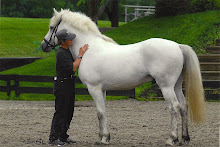Photo by Daniel Region
How
the Other Half Loves
Ghent
Playhouse
6
Town Hall Place
www.ghentplayhouse.org
Watching
Alan Ayckbourn’s play, How the Other Half
Loves, is a little like watching a gold medal table tennis doubles match.
Dialogue pings and pongs back and forth between the characters. Actors cross
above and below each other barely avoiding a collision. Plot lines swirl and
tangle themselves as time and space meet over dinner. It’s a biting comment on marriage, workplace
ethics and class.
And it’s funny— very
funny.
Premiered in 1969, the
play follows three couples as they try to sort out their marriages and further
their careers. Frank Foster (Sky Vogel who doubles quite ably as director)
employs Bob Phillips (Todd Hamilton) who has had a one-night stand with Fiona
Foster (Prudence Theriault). Bob’s wife, Teresa (Christina Smith) is a
frustrated mother with a wild offstage child. In an attempt to conceal their
affair, Bob and Fiona implicate another couple–the Detweilers (the
Featherstones in the original production).
William Detweiler has recently been hired by Frank. Detweiler’s wife, Mary, is a shy and retiring
woman who is being trained by William to be a good “businessman’s wife.”
Just to add a bit of
zest to the mess, Ayckbourn has staged the action, which takes place
simultaneously in two separate houses, on the same set. Indeed, he has two
dinner parties taking place on two different nights at one table in the same
scene.
If you are finding it
difficult to follow the synopsis, imagine the skill it takes to enact it. It’s a little like tossing a hot potato back
and forth while dancing a complicated figure as you speak your lines at
precisely the right time and pitch. All the while making sure you’re funny and
engaging as well as convincing. Nor is
it just the actors who have to be on their toes. Lighting, especially during
the dinner party scene, plays a major role in creating both the illusion of separation
and a sense of unity throughout the piece.
After having watched
several YouTube videos from bigger theaters’ stagings of Ayckbourn’s famous
dinner scene, I have to say that the Ghent Players and their crew rocked it
solid.
In particular, Sam Reilly
and Amber Herrick, as the Detweilers, showed great skill in handling the speedy
transitions required of them. Christina Smith and Todd Hamilton both did a
wonderful job of creating drunken chaos while Prudence Theriualt made her
dinner party chilly. Throughout the play, Sky Vogel’s Frank, the maestro of
misunderstanding, does a great job of speeding up or slowing down the action. His performance helped to center the
maelstrom. Major credit must go to
lighting designer Ben Heyman whose use of a chandelier/hanging dining room
light fixture helped the audience track what was going on. His lightboard must have been sizzling from
the rapid changes!
Set designers and
decorators (Ben Heyman, Sky Vogel, Todd Hamilton & Nancy Hammell) did well
given the space constraints. I think that the contrast between the uptight
Foster’s upper/middle class home and the slovenly white-collar house of the
Phillips could have been made more obvious. Joanne Maurere’s costumes evoked
the polyester-era well though again I felt that the class divisions were not
quite strong enough.
One major point of
confusion for me comes from a note in the program stating that the play is
taking place in the present. There is a
conversation between Frank and Teresa in which Teresa places the action as
happening in the early 1980s. The clothing and props reminded me of the ‘70s
while the furnishings were much earlier.
This led me to wonder about the accuracy of Ayckbourn’s comment that the
play needs to be placed in 1969 and being British, I assume he would prefer a
British setting. Stereotypes help a
writer take short cuts so it is much easier to imagine the Fosters as the
stereotypical distracted British lord and self-important lady of the
manor. The Phillips’ drunken brawls and
the Detweilers’ middle class modest and fearful demeanor have been BBC fodder
for decades. Too, English accents
designate class better than American leaving American producers with the
challenge of showing class through design elements rather than language.
But I’m not sure if How the Other Half Loves would have been
more poignant if there had been greater class delineation between the
couples. Ultimately the writing is so
funny and the action so quick that one is never given a chance to experience
the pathos of affairs, poor communication, sycophancy, wild children,
drunkenness and manipulative spouses. I
suppose pacing the play differently would give the audience a chance to think
about what is happening and to identify with one or more of the characters and
situations. But then it would become
what I was afraid it was going to be: one of those terribly pedantic, stilted,
depressing domestic tragedies in which clever people say nasty things about
nothing in particular.
Happily, the Ghent
Playhouse met the challenge well and I had a wonderful time. I laughed a lot. And I came away feeling very proud of my
community theater. Well done!
And… please be sure to
buy raffle tickets for the 50/50 drawing!
For a mere pittance you get a chance to bring home half of all they
collect— the other half going to the theater.







